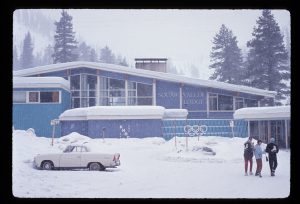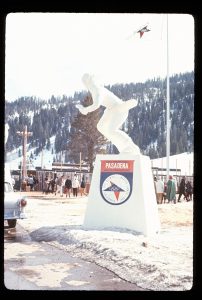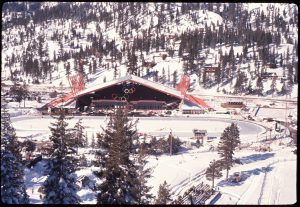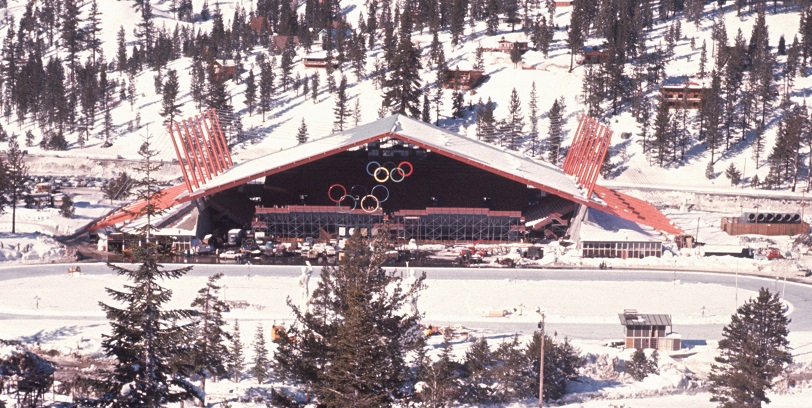In September 2022, Gov. Gavin Newsom signed legislation (AB 2022; Chapt. 479, Stats of 2022) which requires the term “squaw” to be removed from all geographic features and place names in the state by 2025. The term, used on nearly 100 place names across California, was removed due to its use as a derogatory term. In this article, the term has been used in the context of the place name of the historic event, which has since been renamed “Palisades Tahoe.”

In the midst of a blizzard, 20,000 spectators watch the Walt Disney-produced opening ceremonies of the 1960 Winter Olympics at Squaw Valley California. Disney has lined up 5,000 entertainers. Two thousand doves are released after the first modern playing of what’s now known as the “Olympics theme.” As the 740 competing athletes from 30 countries enter the newly built Blyth Memorial Ice Arena, what’s billed as the first-ever daytime fireworks are launched.
Prentis Cobb Hale, president of the Olympic Organizing Committee, says in his welcome:
“Before we pay so much attention to conquering outer space, we should devote ourselves to conquering inner space: the distance between nations.”
Vice President Richard Nixon officially opens the games. Actor Karl Malden reads an Olympic prayer. As the athletes parade out of the arena, 30,000 balloons are released accompanied by a military salute in which shells explode to display flags of each nation carried to the ground by parachutes.
It’s the first Winter Olympics with an Olympic Village where athletes stay during the games. It’s also the first winter Olympics to include women’s speed skating and the biathlon. It’s the first – and last – winter games in which there are no bobsled events. Organizers feel with only nine countries mounting luge or bobsled teams the prohibitive construction costs aren’t justified. Squaw Valley is also the first Olympics to sell TV rights. CBS pays $50,000 for the privilege of exclusive broadcasting of the 10-day competition and, in the process, creates “instant replay.” Unsure whether a skier missed a gate in the men’s slalom, officials ask CBS if they can review videotape. Instant replay is born.
The successful pageantry is a far cry from six years earlier when Alexander Cushing, head of the Squaw Valley Development Company, first bids for the 1960 Olympics. As recently as 1956, there is nothing in the valley except a 50-room lodge, a chair lift and two rope tows on the development company’s 640 acres. After being selected by the International Olympic Committee, Cushing claims his initial motive was simply publicity after he saw the ink received by Reno, Nevada when announcing its bid for the 1960 Olympics. Cushing tells Time in a 1959 interview:
“I had no more interest in getting the Games than the man in the moon. It was just a way of getting some newspaper space.”

For a publicity stunt, Cushing sure puts in a lot of effort. He enlists the aid of his local state senator Harold “Bizz” Johnson and Gov. Goody Knight who convinces the Legislature to appropriate $1 million to pay for the games should Cushing’s effort succeed. Both Knight and his successor, Gov. Pat Brown, view the Olympics as a way to showcase California to a worldwide audience. In January 1955, the United States Olympic Committee recommends Squaw Valley over Reno, Anchorage and Sun Valley as site for the 1960 Olympics. Avery Brundage, chair of the International Olympic Committee, tells Cushing the US Olympic Committee members have “taken leave of their senses.” Cushing intensifies what he calls his “snow job” of selling of Squaw Valley, cajoling and buttonholing members of the International Olympics Committee. Eventually, Squaw Valley narrowly beats Innsbruck, Austria on a 32 to 30 vote. Over the next four years, $80 million is spent –mostly state and federal dollars – improving roads and building hotels, restaurants, administration buildings, a Sheriff’s office and a sewage treatment plant as well as the 8,500-seat ice arena (demolished in 1983), three outdoor skating rinks, a 400-meter speed skating oval and four athlete dormitories.

It being the Cold War, in 1957 America threatens not to issue visas to athletes from Communist countries like China, North Korea and East Germany. The International Olympic Committee says the United States is free to do so but that will mean the 1960 Olympics will be held elsewhere. When the games begin, the Soviet Union, America’s opponent in the Space Race, dominates, taking home 21 medals, one-third of them gold. The men’s downhill’s skiing is won by France’s Jean Vuarnet, after whom the line of sunglasses are named. It’s the first medal won by someone using metal instead of wooden skis. American figure skater Carol Heiss is Ladies Singles champion.
The United States hockey team wins the gold – America’s first gold medal in ice hockey — upsetting Canada and the Soviet Union.
Soviet hockey teams take home the gold in the next four winter Olympics until the United States wins again in 1980.
